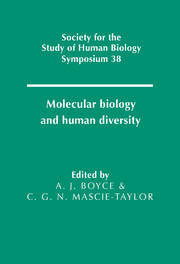Book contents
- Frontmatter
- Contents
- List of contributors
- Preface
- 1 Mitochondrial DNA in ancient and modern humans
- 2 Digital DNA typing of human paternal lineages
- 3 Minisatellites as tools for population genetic analysis
- 4 DNA fingerprinting: development of a technology and its application to the study of human populations
- 5 Kinship, inbreeding, and matching probabilities
- 6 Using the coalescent to interpret gene trees
- 7 Some attempts at measuring natural selection by malaria
- 8 AIDA: Geographical patterns of DNA diversity investigated by autocorrelation statistics
- 9 Mitochondrial DNA sequences in Europe: an insight into population history
- 10 Palaeolithic and neolithic contributions to the European mitochondrial gene pool
- 11 The molecular diversity of the Niokholo Mandenkalu from Eastern Senegal: an insight into West Africa genetic history
- 12 The peopling of Madagascar
- 13 Molecular perspectives on the colonisation of the Pacific
- 14 Population ancestry on Tristan da Cunha–the evidence of the individual
- 15 Linguistic divergence and genetic evolution: a molecular perspective from the New World
- 16 Allelic sequence diversity at the human β-globin locus
- 17 A nuclear perspective on human evolution
- 18 Contrasting gene trees and population trees of the evolution of modern humans
- 19 Methods and models for understanding human diversity
- Index
4 - DNA fingerprinting: development of a technology and its application to the study of human populations
Published online by Cambridge University Press: 19 September 2009
- Frontmatter
- Contents
- List of contributors
- Preface
- 1 Mitochondrial DNA in ancient and modern humans
- 2 Digital DNA typing of human paternal lineages
- 3 Minisatellites as tools for population genetic analysis
- 4 DNA fingerprinting: development of a technology and its application to the study of human populations
- 5 Kinship, inbreeding, and matching probabilities
- 6 Using the coalescent to interpret gene trees
- 7 Some attempts at measuring natural selection by malaria
- 8 AIDA: Geographical patterns of DNA diversity investigated by autocorrelation statistics
- 9 Mitochondrial DNA sequences in Europe: an insight into population history
- 10 Palaeolithic and neolithic contributions to the European mitochondrial gene pool
- 11 The molecular diversity of the Niokholo Mandenkalu from Eastern Senegal: an insight into West Africa genetic history
- 12 The peopling of Madagascar
- 13 Molecular perspectives on the colonisation of the Pacific
- 14 Population ancestry on Tristan da Cunha–the evidence of the individual
- 15 Linguistic divergence and genetic evolution: a molecular perspective from the New World
- 16 Allelic sequence diversity at the human β-globin locus
- 17 A nuclear perspective on human evolution
- 18 Contrasting gene trees and population trees of the evolution of modern humans
- 19 Methods and models for understanding human diversity
- Index
Summary
Hypervariable sequences and DNA fingerprinting
The most polymorphic loci known in the human genome are tandemly repeated minisatellites (MS) and microsatellites (MCS), hundreds of which have been described and mapped. Jeffreys and his colleagues (Jeffreys, Wilson & Thein, 1985) were the first to show that probes derived from the human myoglobin gene (probes 33.6 and 33.15) could hybridize to several minisatellite loci, producing complex and individual-specific banding patterns called ‘DNA fingerprints’. Many other multilocus and single-locus probes have since been described (see Pena & Chakraborty, 1994). Fig. 4.1 shows an example of DNA fingerprints obtained with a multilocus probe, M13 phage DNA, which was independently discovered by Vassart et al. in Belgium (Vassart et al., 1987) and by Ryskov et al. in Russia (Jincharadze, Ivanov & Ryskov, 1987; Ryskov et al., 1988). This probe contains a minisatellite (M13-ms) which consists of repeating 15 bp sequences GAGGGTGGXGGXTCT. It detects a set of hypervariable regions in human DNA and makes it possible to estimate individual specificity as well as to establish paternity relationships. Ryskov et al. (1988) tested M13-ms for hybridization with DNA from many species and demonstrated a wide distribution of this MS in different taxonomic groups including man, animals, plants, bacteria. This peculiar characteristic of M13-ms allows one to apply its analysis for studying genomic diversity in different species.
- Type
- Chapter
- Information
- Molecular Biology and Human Diversity , pp. 29 - 50Publisher: Cambridge University PressPrint publication year: 1996
- 1
- Cited by



